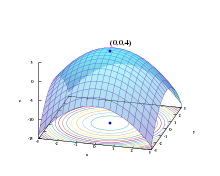
Back استمثال (رياضيات) Arabic Optimallaşdırma Azerbaijani Оптималләштереү (математика) Bashkir Математическа оптимизация Bulgarian গাণিতিক কাম্যতমকরণ Bengali/Bangla Optimització matemàtica Catalan Optimalizace (matematika) Czech Optimering (matematik) Danish Mathematische Optimierung German Βελτιστοποίηση Greek
This article needs additional citations for verification. (February 2024) |


Mathematical optimization (alternatively spelled optimisation) or mathematical programming is the selection of a best element, with regard to some criterion, from some set of available alternatives.[1][2] It is generally divided into two subfields: discrete optimization and continuous optimization. Optimization problems arise in all quantitative disciplines from computer science and engineering[3] to operations research and economics, and the development of solution methods has been of interest in mathematics for centuries.[4]
In the more general approach, an optimization problem consists of maximizing or minimizing a real function by systematically choosing input values from within an allowed set and computing the value of the function. The generalization of optimization theory and techniques to other formulations constitutes a large area of applied mathematics.
- ^ "The Nature of Mathematical Programming Archived 2014-03-05 at the Wayback Machine," Mathematical Programming Glossary, INFORMS Computing Society.
- ^ "Mathematical Programming: An Overview" (PDF). Retrieved 26 April 2024.
- ^ Martins, Joaquim R. R. A.; Ning, Andrew (2021-10-01). Engineering Design Optimization. Cambridge University Press. ISBN 978-1108833417.
- ^ Du, D. Z.; Pardalos, P. M.; Wu, W. (2008). "History of Optimization". In Floudas, C.; Pardalos, P. (eds.). Encyclopedia of Optimization. Boston: Springer. pp. 1538–1542.
© MMXXIII Rich X Search. We shall prevail. All rights reserved. Rich X Search
